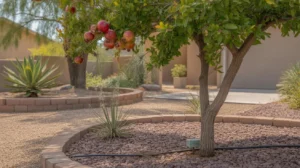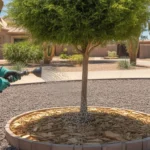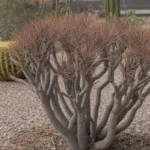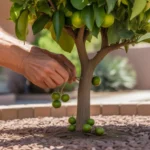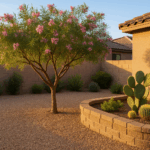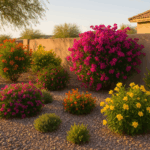While Queen Creek’s intense summer heat can make growing fruit seem daunting, there are actually several unique fruit trees that not only tolerate our scorching temps but thrive in partial shade. By choosing the right shade fruit trees for Queen Creek, you can enjoy fresh homegrown flavors while making the most of sheltered microclimates in your yard.
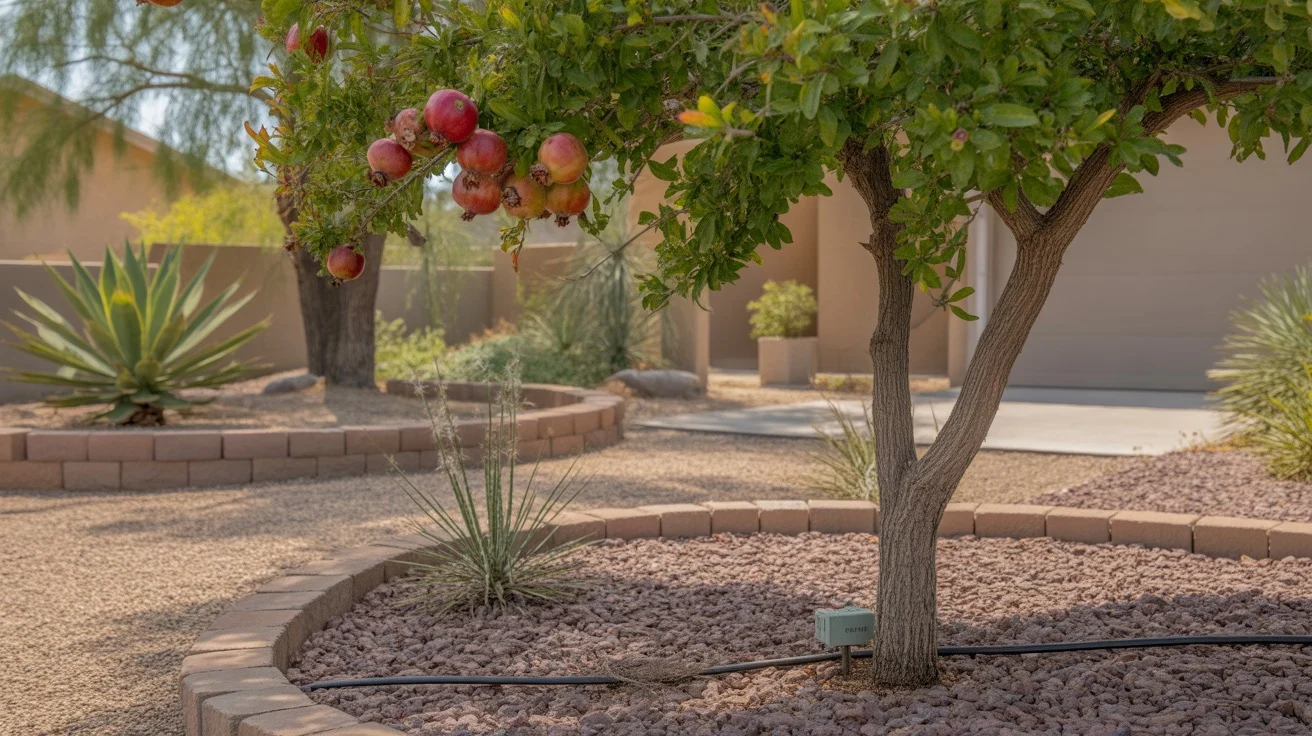
Jujube: The Versatile Chinese Date
Also known as the Chinese date, the jujube (Ziziphus jujuba) is a small deciduous tree that’s remarkably well-adapted to Queen Creek’s desert conditions. Jujubes can tolerate both full sun and partial shade, making them a great choice for yards with east-facing walls or light-filtering shade structures.
Jujube trees produce small, date-like fruits that can be eaten fresh or dried. The fruits have a sweet, apple-like flavor and are packed with vitamin C. ‘Li’ and ‘Lang’ are two popular cultivars that perform well in Queen Creek. Plant jujubes in well-draining soil and water deeply but infrequently once established.
Pomegranate: Jewels of the Desert
Pomegranates (Punica granatum) are deciduous shrubs or small trees native to the Middle East. They’re surprisingly cold hardy and can handle both Queen Creek’s chilly winter nights and intense summer heat. While pomegranates do best with full sun exposure, they can still produce plenty of fruit with some light shade.
The ruby-red arils inside pomegranates are prized for their sweet-tart flavor and antioxidants. ‘Wonderful’ is the most common pomegranate variety and a reliable producer in Queen Creek. Plant pomegranates in well-draining soil and allow the soil surface to dry between deep waterings. Pomegranates can also make an attractive informal hedge.
Figs: Ancient Fruits for Modern Yards
Figs (Ficus carica) have been cultivated for thousands of years and are well-suited to Queen Creek’s climate. These deciduous trees can grow quite large but are easy to keep smaller with pruning. Figs can handle both full sun and partial shade, making them a versatile addition to desert yards.
Queen Creek gardeners have several fig varieties to choose from, including ‘Black Mission’, ‘Brown Turkey’, and ‘White Kadota’. Figs can produce two crops per year – the early “breba” crop and main crop. Plant figs in well-draining soil and water deeply every 1-2 weeks during the growing season, tapering off in fall and winter.
White Sapote: The Creamy Tropical Treat
White sapote (Casimiroa edulis) is an evergreen tree native to Mexico and Central America. It’s sometimes called the “Mexican apple” for its round, green fruits with creamy white flesh. White sapotes have a unique flavor reminiscent of peaches, bananas, and vanilla custard.
In Queen Creek, white sapotes do best with light shade or on the north or east side of structures. They’re surprisingly cold-tolerant but will appreciate protection from reflected heat. ‘Suebelle’ and ‘Denzler’ are two popular cultivars. White sapotes have a shallow root system, so avoid disturbing the soil and apply a thick layer of organic mulch.
Pineapple Guava: Feijoas in the Desert
Pineapple guava (Acca sellowiana), also known as feijoa, is an attractive evergreen shrub native to South America. It thrives in Queen Creek with partial shade and produces unique flowers with edible petals in spring. The oval green fruits have a pineapple-mint flavor and are rich in vitamin C.
Pineapple guavas can tolerate full sun in Queen Creek but benefit from light shade during the hottest months. They’re also surprisingly cold-hardy. ‘Coolidge’ and ‘Nazemetz’ are two recommended varieties for desert climates. Plant pineapple guavas in well-draining soil and allow to dry slightly between waterings.
Tips for Growing Shade Fruit Trees in Queen Creek
While these shade-loving fruit trees are well-adapted to Queen Creek’s climate, there are a few key things to keep in mind to ensure success:
- Choose the right microclimate. Observe your yard to find areas with light, dappled shade or locations shaded during the hottest part of the day, such as the north or east side of walls or shade structures.
- Improve your soil. Queen Creek’s desert soils are often lean and fast-draining. Amend planting areas with compost or well-aged manure to improve fertility and moisture retention.
- Mulch heavily. Apply a 3-4 inch layer of organic mulch around fruit trees to regulate soil moisture and temperature. Keep mulch a few inches away from the trunk to avoid rot.
- Water wisely. Most fruit trees benefit from deep, infrequent watering. Use drip irrigation or soaker hoses to deliver water slowly and efficiently. Avoid wetting foliage, which can lead to fungal issues.
- Provide frost protection. While these fruit trees tolerate Queen Creek’s winters, young trees may still benefit from frost cloth during hard freezes. Avoid planting in low-lying cold pockets.
By choosing shade-loving fruit trees well-suited to Queen Creek’s unique climate and providing thoughtful care, you can enjoy delicious homegrown harvests while making the most of sheltered microclimates. From the unusual jujube to the ancient fig, these fruit trees offer fresh flavors and attractive foliage to enhance any desert yard.

